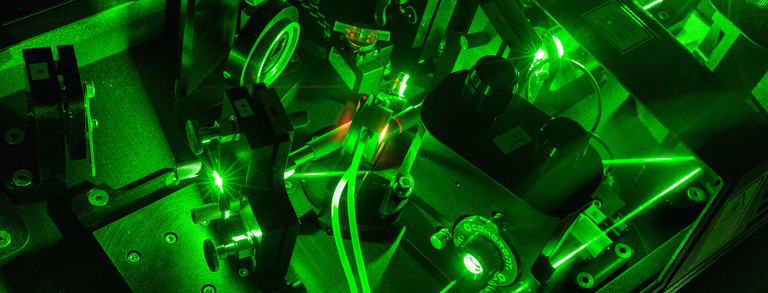Ultrafast Acoustics
The key elements of our field of research are laser generated acoustic phonon pulses, which are used to alter the optical properties of various sample systems. Usual timescales of such acoustic pulses are in the order of picoseconds and thus carry frequencies up to a few THz. To excite such picosecond phonon pulses we are using the ultrafast acoustics technique. A thin metal film is deposited onto the sample structure. It acts as a photo-acoustic transducer which is excited by high intense femtosecond laser pulses. The optical energy is converted into phonons and consequently a phonon pulse is injected into the sample structure.
Taking into account the speed of longitudinal sound in semiconductors (usually in the order of a few 1000 m/s) the frequencies corresponds to wavelengths as low as a few nanometers. Thus, these acoustic pulses are suitable to investigate semiconductor quantum heterostructures (such as quantum wells, quantum dots, semiconductor microcavities, etc.), which are structured on similar lengthscales. Subject of this probing are the optical properties of the investigated structure, while we are using a manifold of different optical detection methods.
In a different approach we are exploiting the broadband character of the phonon pulse. Sample structures, where this character is important are opal based photonic-phononic crystals. The phononic crystal character leads to the formation of a phononic band structure, including bandgaps. The broadband acoustic pulse allows us to probe this bandstructure, using optical pump-probe reflectivity techniques.
Also magnetic properties can be manipulated by strain. In our group we are investigating thin diluted magnetic semiconductor films, for example (Ga,Mn)As. With the previously mentioned phonon pulses we are able to manipulate the Mn spin system on picosecond timescales, which is probed by measuring the Kerr-rotation angle in an optical pump-probe scheme.
News
At the moment we are investigating the interplay of acoustic pulses and plasmonic excitations.
Main Results
Laser mode feeding by shaking quantum dots in a planar microcavity
Semiconductor light emission can be changed considerably in an optical resonator. Prerequisite is that the electronic transitions involved in light generation are in resonance with a cavity mode. Although resonance can be arranged through dedicated fabrication, there are cases where this is virtually impossible. As an example, we study a planar microcavity containing an inhomogeneous quantum dot ensemble with a spectral broadening much larger than the optical mode width, so that resonance is achieved for a tiny dot fraction only. Still, the laser threshold can be crossed at moderate optical pumping. We demonstrate that strain pulses generated by ultrafast acoustics techniques can be used to modulate the transition energies so that resonance with the optical mode is dynamically induced for a much larger dot fraction. As a result, the emission output can be enhanced by more than two orders of magnitude, which is potentially useful for modulating light sources.
Filtering of Elastic Waves by an Opal-Based Hypersonic Crystal
We report experiments in which high quality silica opal films are used as three-dimensional hypersonic crystals in the 10 GHz range. Controlled sintering of these structures leads to well-defined elastic bonding between the submicrometer-sized silica spheres, due to which a band structure for elastic waves is formed. The sonic crystal properties are studied by injection of a broadband elastic wave packet with a femtosecond laser. Depending on the elastic bonding strength, the band structure separates long-living surface acoustic waves with frequencies in the complete band gap from bulk waves with band frequencies that propagate into the crystal leading to a fast decay.
Coherent Magnetization Precession in Ferromagnetic (Ga,Mn)As Induced by Picosecond Acoustic Pulses
We show that the magnetization of a thin ferromagnetic (Ga,Mn)As layer can be modulated by picosecond acoustic pulses. In this approach a picosecond strain pulse injected into the structure induces a tilt of the magnetization vector M, followed by the precession of M around its equilibrium orientation. This effect can be understood in terms of changes in magnetocrystalline anisotropy induced by the pulse. A model where only one anisotropy constant is affected by the strain pulse provides a good description of the observed time-dependent response.
Current Offers For Bachelor-, Master- or PhD-Theses
Offers will be made on request. Usually there is always a topic available.
Contact
- Dr. Alexey Scherbakov
- Michal Kobecki
- Dmytro Yaremkevych
- Dr. Felix Godejohann
Collaborations
- University of Nottingham, GB
- A. F. Ioffe physical-technical Institute, Russia
- University of Notre Dame, France
- Université Blaise Pascal, France
- V. E. Lashkaryov Institute of Semiconductor Physics, Ukraine
- Universität Würzburg
- Universität Bremen
- Universität Paderborn
- Universität Bochum
- Centre National de la Recherche Scientifique, France



